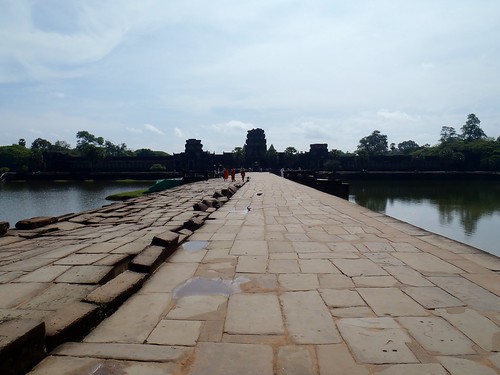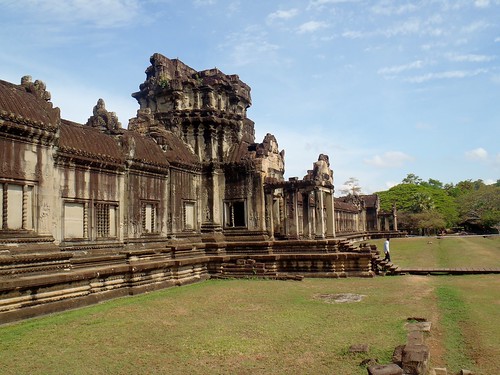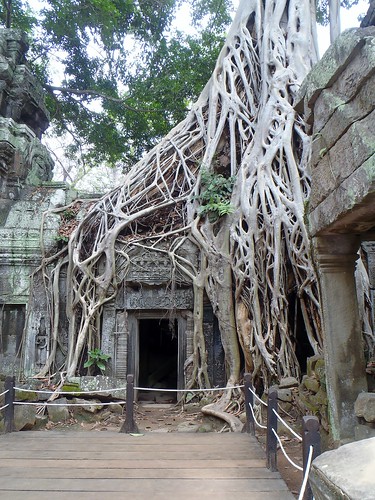Even if you’re someone who doesn’t take the word “epic” lightly, Angkor Wat is a seriously epic place.

This is a place I’ve been wanting to visit for years. Ever since I caught an article in National Geographic about the glorious past of the Khmer Empire. Angkor Wat seemed like it was made for me:Ancient ruins? check. Mysterious past? check. Exotic jungle setting? check. This place is pretty much the pinnacle of all the things I look for in a travel destination. And it was first thing on my list of “must-dos” when I began planning this trip. I used a stock picture as the background on my work computer for months as motivation to sock away money and get myself moving.
This past week I was finally able to realize this goal. I spent a full three days exploring the vast ruins in a bouncy little tuk tuk. March is the hottest month of the year and I sweated more than my body weight in water. I burned out my camera battery three times and ground my flip flops down into cardboard. By the end I was pretty well templed out, but it was so worth it.
I know not everyone is as archaeologically nerdy as me, but here’s why Angkor Wat is so special:
WHAT is Angkor Wat?
Angkor Wat refers not only to the main temple, but to the surrounding archeological park as well. The Angkor ruins are huge; much bigger than I even imagined. There are actually over 1000 ruins, mostly of temples. Some a brilliantly preserved while others are basically just piles of rocks or bricks. Over the course of three days I was able to visit about 20 different temples in many styles.

Angkor Wat is also the name of the largest, most famous temple in the complex. It’s really big (the largest religious building in the world) and covered in beautiful engravings full of Hindu symbolism.
WHERE is it?
In eastern Cambodia, right outside the charming town of Siem Reap. When you visit you will most likely stay in town and hire a guide or tuk tuk driver to show you around the ruins. You can also visit via bicycle.
WHEN were the temples built?
The reason the temples very so greatly in style and religious meaning is that they were built over a period of 600 years- from the 9th to the 15th century AD. The Khmer empire declined rapidly after that and the temples were mostly left to rot in the jungle. Some of the most beautiful temples, in my opinion, are the ones nature has already reclaimed.

Today, with the help of UNESCO, Cambodia is preserving and restoring many of the larger temples. Angkor Wat is a huge source of tourism income for the country- over 2 million people visit anually.
WHO built them?
The people of Angkor, a region of Cambodia that was once home to the vast Khmer empire, one of the most powerful empires in Asian history. There were barely any written records of them so much of their history remains a mystery. To quote the scholars at wikipedia:
In 2007, an international team of researchers using satellite photographs and other modern techniques concluded that Angkor had been the largest preindustrial city in the world, with an elaborate system of infrastructure connecting an urban sprawl of at least 1,000 square kilometres (390 sq mi) to the well-known temples at its core
Touring the area outside of Siem Reap now it’s nearly impossible to imagine the city that one stood here. Most of hte buildings were made of wood and have dissappeared, leaving only the grand religious temples behind.

WHY?
The temples were built as religious monuments, first to the gods of Hinduism, and then eventually to Buddha. Today every temple contains a few buddhist shrines. They were built both for devotional regions and as a show of power and wealth by the ancient kings. Angkor Wat was built by King Suryarvaman II as his own maosuleum (he clearly had a high opinion of himself).
These temples must have taken a great deal of effort to build. Huge stones were imported from all over the kingdom and lovingly intricate engravings adorn most of the sites.

It may be a huge tourist attraction, but Angkor Wat is still a very special place, full of slow decay and unique discoveries. There are shady private corners and wide sweeping views. It was everything I hoped it would be.
Tomorrow: MORE PICTURES.
